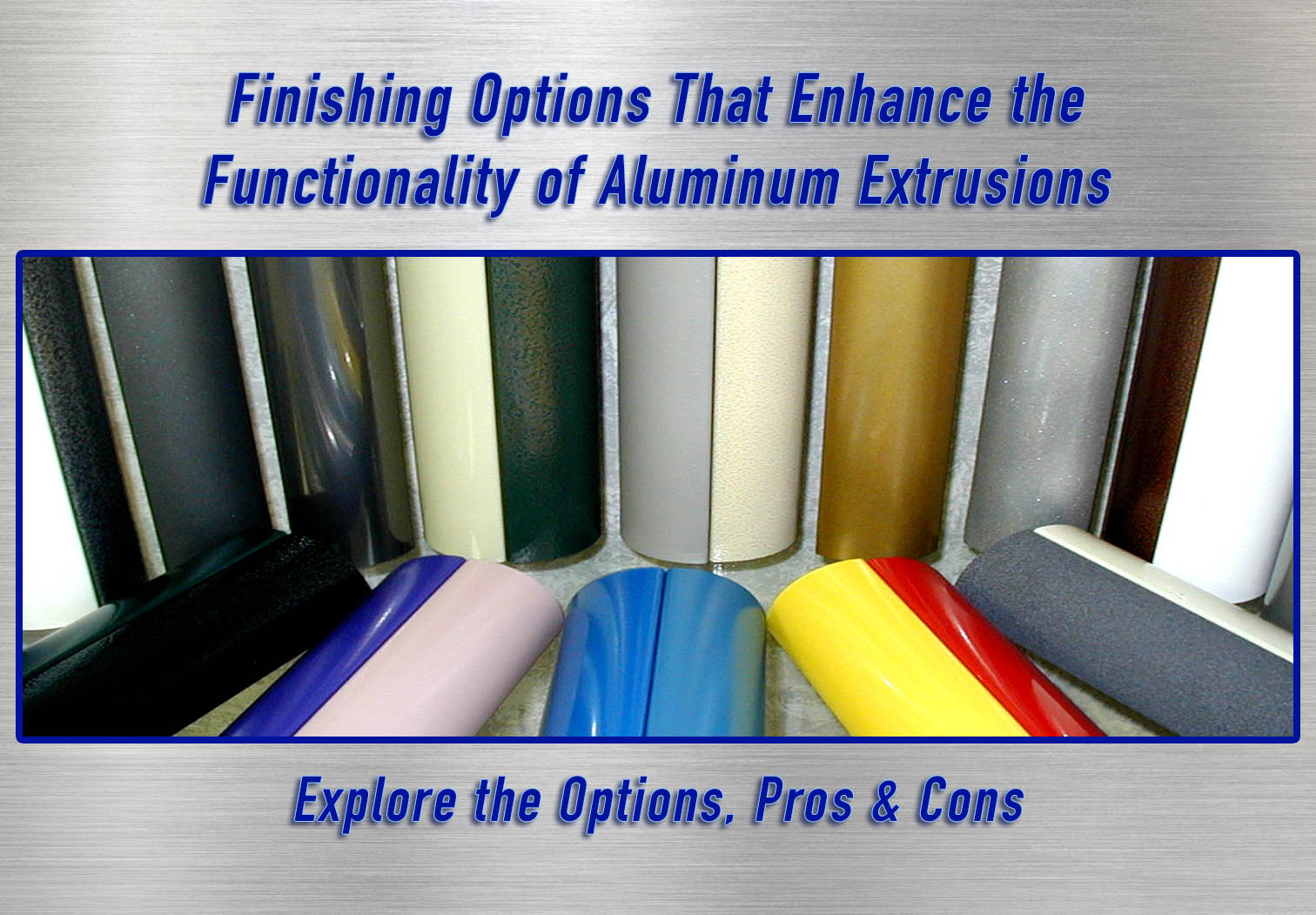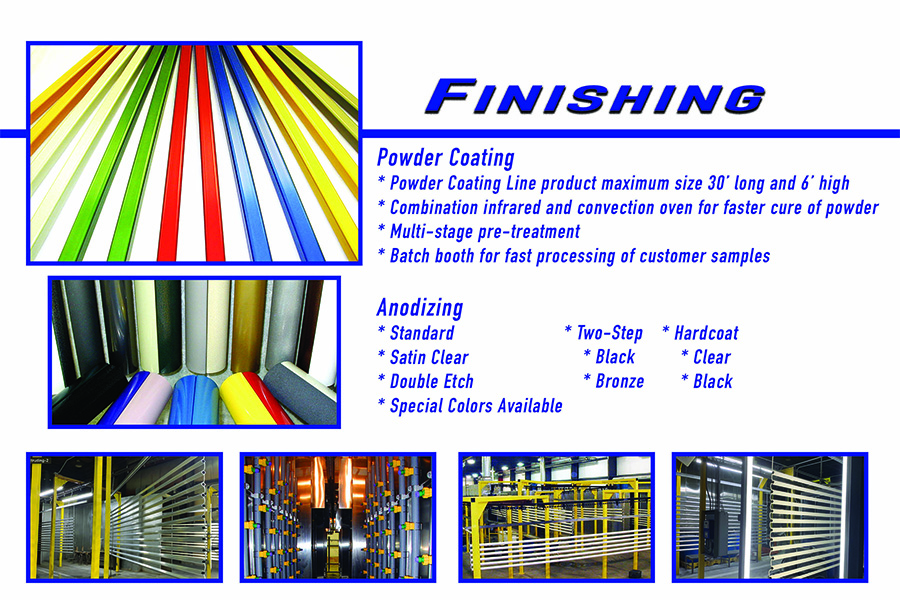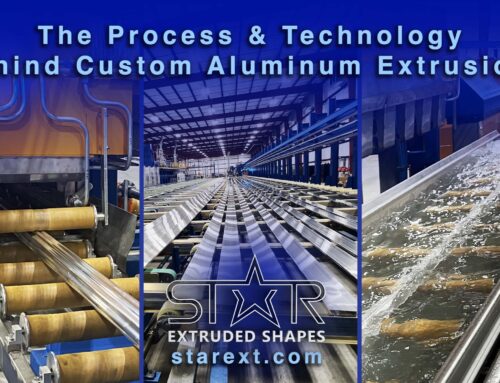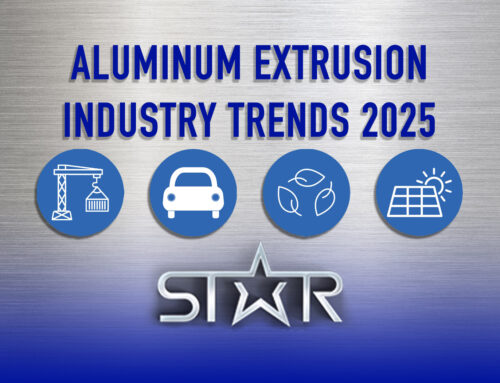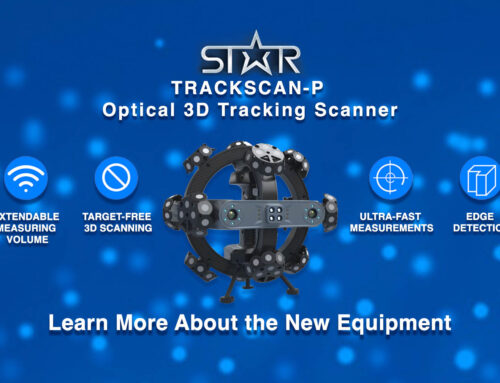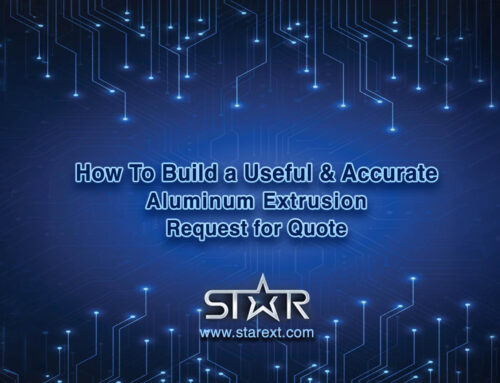With several finishing options available to enhance the functionality of aluminum extrusions, making the right choice requires weighing all the options. This article will outline the types, their description, appearance as well as the benefits and potential pitfalls. Honing in on the finish that will work best for your requirements and needs, is crucial to manufacturing the ideal custom aluminum extrusion component.
Let’s Navigate Your Options
All finishing options for aluminum extrusions offer something different. First, check out this helpful chart, to get familiar with all the options that can enhance functionality of aluminum extrusions.
Finish
Description
Pros
Cons
Mill Finish
The natural finish after extrusion without additional processing. It has a silver, slightly reflective surface that may show die lines.
Economical and suitable for applications where aesthetics is not critical, can serve as a base for additional finishing processes
Extremely thin and can be easily removed. It can also be oxidized under salt and moisture to give a rustic look. Surface may have imperfections and die lines.
An electrochemical process that thickens the natural oxide layer on the aluminum surface.
Corrosion resistance, enhanced surface hardness, UV resistance (ideal for outdoor use). Available in various colors and textures and environmentally friendly.
Adds to the production cost. For multiple batches, color variation can occur. It makes aluminum extrusion products harder to bend and fabricate.
A dry powder is electrostatically applied and cured under heat to create a uniform, durable finish.
Durable and resistant to chipping, scratching, and fading. Comes in a wide range of colors and textures, high UV and corrosion resistance and environmentally friendly (low VOC emissions).
Can be challenging to complete minor touchups, has a high startup cost for the equipment. Creates a relatively thick coating without uniform thickness. It can fade over time from exposure to sunlight without certain additives. Powder coating is applied using a spray gun, making it challenging to evenly coat complex parts, particularly those with hidden interior surfaces.
Painting (Liquid Coating)
Wet paint applied via spraying or dipping.
Allows for custom colors and textures, can be used for decorative purposes. Suitable for indoor and outdoor use.
Many liquid coatings are high in VOC, which limits their use in regulated areas. Requires experienced application. Spray booths with sufficient ventilation and other capital expenditures are necessary to use the products in a controlled, clean, and safe environment. Also, insurance costs to use and store solvent-based paints and flammable solvents and paints are high.
Mechanical Finishes
Polishing, brushing, sanding, grinding, or tumbling.
Improves surface smoothness and uniformity, enhances aesthetics with finishes such as mirror polish or satin. Removes surface imperfections.
Requires precise control, and miscalculations or incorrect techniques can cause problems. The coating may not adhere properly, or it may be uneven, cracked, or flaking. The coating may be hazy or dull, or have blisters, pitting, or oxidation.
Electroplating
A metal coating (e.g., nickel, chrome) applied to the surface using an electrochemical process.
Improves wear resistance, adds a shiny, decorative metallic finish, while enhancing corrosion resistance.
The coating may not be uniform. Uses chemicals and pollutants that can be harmful to the environment. Can be expensive due to the cost of materials, energy, and environmental considerations
May be time-consuming, especially for large or complex objects.
Chemical Finishes
Etching, bright dipping, or chemical polishing.
Creates specific surface textures (e.g., matte or glossy). Improves reflectivity or diffuses surface irregularities and prepares surfaces for further finishing.
Less durable than other finishes like anodizing, potentially having limited color options. Being susceptible to scratches, and sometimes requiring additional coatings for better wear resistance, especially in applications with high abrasion or wear demands. Additionally, some chemical conversion coatings may have environmental concerns due to the chemicals used in the process.
Thermal Finishes
Thermal spraying or heat-treating.
Enhances surface properties for high-temperature applications. Improves adhesion of subsequent coatings.
May result in thermal expansion and reduced strength. The aluminum can corrode, especially when exposed to other metals. Lighter colors on aluminum can fade more easily. Paint or finish may degrade and leave a powdery residue. Can cause thermal resistance. Thermal spray equipment and skilled labor can be expensive. Thermal spray coatings can be thick, which can affect dimensional accuracy. It might not bond well with certain substrates.
Bead Blasting
A mechanical process that uses pressurized air to blast abrasive particles (e.g., glass beads or sand) onto the surface.
Creates a uniform, matte surface with a satin-like texture. Hides minor imperfections and scratches, while enhancing surface adhesion for subsequent finishes.
Time-consuming, not ideal for tight tolerances, difficult for intricate parts. May not be effective on paint or corroded parts and can create an uneven surface. Generates dust and debris, requiring PPE for operators. Requires a highly skilled operator.
Conversion Coatings
A chemical reaction that transforms the aluminum surface into a thin, protective layer.
Provides a base for paint or powder coating by improving adhesion, adds corrosion resistance to uncoated surfaces. Suitable for applications where secondary finishing is required. Conversion coatings are protective coatings that enhance the oxide layer on a metal part’s surface. They are commonly used on aluminum parts in aerospace and defense manufacturing.
Potential for an uneven coating or a dull brown color on the surface. The coating may fail in salt spray tests. Health hazards such as acute and chronic health effects as well as skin and eye irritation can occur. Safer conversion coating materials: Safer conversion coating materials are being evaluated.
Hard Coating (Hard Anodizing)
An electrochemical process that creates a hard oxide layer. Aluminum is submerged in a sulfuric acid bath.
Superior wear and abrasion resistance. Increased corrosion resistance and suitable for high-stress applications, such as automotive or aerospace.
Increased brittleness making it prone to chipping or cracking under impact. Limited color options due to the thicker coating, higher cost compared to standard anodizing and potential for increased surface roughness. it can also reduce fatigue strength of the base metal.
Bright Dipping
A chemical process that enhances the natural brightness and reflectivity of aluminum.
Produces a shiny, mirror-like finish. Used for decorative purposes in architectural or consumer products.
Potential for surface damage if not done properly, high toxicity of the chemical bath used (phosphoric and nitric acids). It can have a limited ability to remove deep scratches or pits. Also, it presents environmental concerns due to hazardous fumes, and the need for careful handling and specialized equipment to achieve a good finish.
Vibratory Finishing
Aluminum parts are placed in a vibrating bowl with abrasive media to smooth and polish the surface.
Deburring and edge rounding creates a uniform, polished surface, suitable for mass finishing of small to medium-sized parts.
Inconsistent results, damage to delicate parts can occur, and the need for expensive equipment is required.
Textured Finishes
Stippled, knurled, or patterned surfaces created during extrusion or with post-processing tools.
Improves grip for functional applications (e.g., handles, railings). Adds a distinctive aesthetic appearance while reducing glare or reflection.
Can be inconsistent in finish, less polished appearance. May also be labor intensive.
Clear Coat Finishes
Transparent coatings applied over aluminum to protect the surface, while maintaining its natural appearance.
Protects against oxidation and environmental wear. Retains the aluminum’s original look and is ideal for applications requiring a natural metallic finish.
Difficulty achieving proper adhesion due to aluminum’s unique surface properties, potential for yellowing over time, inconsistency in appearance on lighter colors, and sometimes being less durable than other aluminum finishes like anodizing, especially in harsh environments.
Laser Engraving
A precision laser is used to etch designs, logos, or text into the aluminum surface.
Highly accurate and permanent. No additional materials required. Suitable for branding, serial numbers, or decorative patterns.
High cost due to equipment requirements and skilled operators needed. The process can use a lot of energy, which can also increase costs. The laser beam can create burrs on the edges of the engraving that need to be smoothed out. Aluminum melts at around 1200°F, so heat can be a problem.
Now, with our reference sheet ready, let’s select the best finish to enhance functionality of an aluminum extrusions part.
Concerns & Considerations
A customer has determined that aluminum extrusions are the most suitable material for their new outdoor awning product. The decision was influenced by the material’s lightweight nature, customizability, consistent shape, and cost-effective manufacturing. They prefer not to use a raw unfinished surface (mill finish) on their custom aluminum extrusion part. Therefore, it is necessary to decide on a finishing method that meets their visual expectations and can enhance functionality of aluminum extrusions and withstand outdoor elements such as fluctuating temperatures, UV exposure, and moisture. Additionally, the finish needs to be consistent in thickness to ensure that all parts function and fit together properly with minimal to no damage during transport. The customer also intends to offer buyers of the new awning system color options to customize the finish to match or complement the fabric of the awning.
Options
Based on the customer requirements and concerns, either anodizing or powder coating would be suitable for enhancing the functionality of aluminum extrusion parts in this scenario. Both methods are durable, weather and UV resistant, and offer various color options.
Solution
After evaluating the options, powder coating emerged as the winner. It provides durability, weather and UV resistance, and a wider range of color and texture choices. Additionally, it is more cost-effective for larger batches of extrusions, making it the best choice for the client.
Star Extruded Shapes sales team is highly experienced working hand in hand with clients to ensure expectations are met and exceeded, when considering finish options. Come to our team with a clear vision of where and how a part will be utilized and they will be able to find the finishing options that enhance the functionality of your aluminum extrusions.
Let’s Connect!
Contact our team today to discuss your project requirements and get a quote. Discover why countless clients choose their exceptional services. Don’t hesitate to contact Star and take the first step towards the success of your project!
Follow Star Extruded Shapes on Socials!
Facebook: https://www.facebook.com/profile.php?id=100063753529991
LinkedIn: https://www.linkedin.com/company/star-extruded-shapes
YouTube: https://www.youtube.com/channel/UCep7i_8CZmfokXdXkGEhRJw


